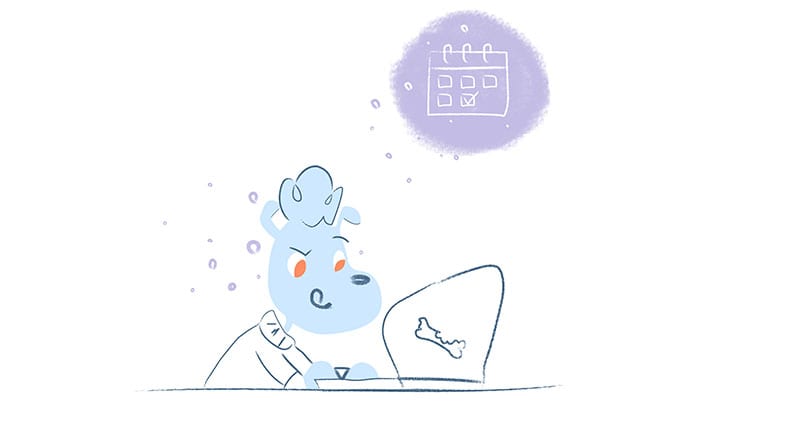

You’ve probably heard that old proverb about time before — it can’t be bought, only spent. But don’t let this get you worrying about how limited a resource your time is. You have to be wise about how you spend it, but it’s not as demanding as you’d think. Time is what you make of it; it can work for you when you use it efficiently.
Keep reading for tips and tricks on effectively using your time and getting more out of it.
1. Use a Calendar
If you’re not already using a calendar to schedule your everyday life, it’s probably time to jump on the bandwagon. This is one of the easiest resources to utilize and maintain, and it’s potentially one of the cheapest, whether a paper or online calendar app; keeping a schedule is in your best interest for several reasons.
Without a schedule, you’re more likely to forget tasks you need to do or when you need them done. Entering all your deadlines, appointments, or meetings in one calendar can help you visualize what needs to be done. You can also effectively prioritize these tasks based on their due date, which will be right before you.
You can also take your calendar to the next level by scheduling your daily tasks. When you start work for the day, survey everything you need to finish by the time you sign off. Then, you can create a daily schedule based on each task that needs to be completed. Just make sure you include breaks, so you have time to breathe in between.
Calendars can also help keep you on task during your limited amounts of time through notification reminders. When you set up an event on your calendar app, you can set a reminder at a specific time. A notification will pop up on your phone or computer that lets you know your deadline or meeting, for example, is coming up soon. Therefore, your calendar can be an effective tool for your life, regardless of whether you use it for work, school, or personal scheduling.
2. Prioritize Specific Tasks
Another way to maximize your time? Start prioritizing specific tasks, whether by importance or deadline. The way your workflow goes will determine how you might decide this.
By Importance
If you have a big project coming up, it’s a good idea to prioritize working on it above other smaller projects. Few things are more stressful in life than having to rush to complete a big assignment in a limited amount of time. When you set your work priorities based on which tasks are most important, you can eliminate this situation.
And this doesn’t mean you should put off or ignore the smaller tasks in between. Instead, you’ll need to structure your workflow to allow for pauses during the big projects to work on the little ones. For example, if you have a minor assignment due tomorrow, make sure you take a break from working on the big project today. Finish the smaller one; then, you can get back to the more critical task. It’s all about keeping a balance based on significance.
This way of tackling your assignments in a limited time can also give you a sense of more variety. Instead of working on one project at a time, you can switch around with as many as you’d like. This is especially great for people who can get bored easily.
By Deadline
This workflow might work better if you like to start and finish the same project without anything else in between. This is especially true if most of your assignments are generally the same size or importance.
Structure your workday based on what needs to be completed first. For example, work on what’s due first if you have a task due every day this week. This probably seems pretty straightforward, and it is when you schedule your time wisely.
This method usually shakes its head at skipping around on assignments unless you finish early or really need some variety. Just ensure you keep referring back to your schedule so you don’t forget the order of what’s due.
3. Block Time for Focus
Time blocking is one of the most effective ways to get the most out of your busy workday. This technique somewhat involves scheduling your day in advance, though not as thoroughly as others might require (see #4).
To block time for maximum productivity, you only need to set aside a specific time during the day for focused work. You’ll use this hour to zone in on your project without being distracted. Essentially, you’ll be forcing yourself to stay on task for a predetermined amount of time. Make sure to stay self-disciplined and keep as focused as possible during this blocked time of your day.
Additionally, something about setting a timer and requiring yourself to work hard within those constraints can be motivating. Tell yourself you must finish this task or a specific step within a project within this focus time. You’ll learn how to use less time to complete your work more quickly.
4. Use Time-Friendly Work Techniques
Like time blocking, you can use many other techniques to make your workday more efficient. However, these can take structuring your day to the next level, as they’re designed to be used in a time crunch. The two most effective techniques are the Pomodoro Method and time boxing.
Pomodoro Method
Popularized as a productive studying technique, the Pomodoro Method was created by Francesco Cirillo in the 1980s-90s. He designed this system while studying for the university to help himself stay on task and maximize his time. The great news is you can easily recreate this method — all you need is a timer.
The Pomodoro Method works by emphasizing the importance of the balance between working and taking breaks. You’re less likely to be productive or retain information when you feel frazzled by constant work. And believe it or not, you can still accomplish this balance in a limited span of time.
This technique usually uses intervals of 25 minutes of focused working and five-minute breaks. During break time, taking a walk or chatting with a coworker is best rather than pulling out your phone. Technology can easily distract you and suck you into a time warp.
If repeating this for more extended work periods, you can allow yourself a more extended break after four consecutive repeats of this 30-minute system. Ideally, this longer break will be anywhere from between 15 to 30 minutes. However, if you’re on a roll with your work, it’s okay to continue with the short breaks instead, especially if you’re really pressed for time.
Time Box
The time box method is often used amongst business professionals, similar to time blocking. This still involves taking a specific amount of time to dedicate to uninterrupted work. However, time boxing takes this concept a step further by challenging yourself to finish tasks in a short amount of time.
Remember doing “speed drills” during elementary math class? These were timed assessments involving short addition, subtraction, multiplication, or division problems that could be solved quickly on average. After receiving a sheet of paper full of these math problems, you were given only a few minutes to complete the page. While not everyone could complete every problem, the adrenaline rush of a time constraint acted as a motivator. And not only to finish the task, but also to do your best within that time crunch.
The time box method works similarly to the concept of the speed drill. You’ll set a timer for a short amount of time, say half an hour, to try to complete a specific task. As a race against the clock, you’ll feel motivated to complete your assignment in the allotted time.
You might not be able to finish your task entirely within these time constraints at first. However, the long-term goal is to improve your ability to work efficiently in small periods. You don’t have to be defeated if you need five more minutes to finish your work. After all, practice makes progress.
Use Your Resources
Though time is a resource itself, don’t forget plenty of other resources can help you use time more efficiently. Keeping a schedule, setting reminders, blocking time for focus, and using time-friendly work techniques are all good places to start. As long as you’re putting in the effort, you’ll begin to see results. Who knows, you might even free up some more time for well-deserved rest while at it.
Featured Image Credit: Giallo; Pexels; Thank you!











Angela Ruth
My name is Angela Ruth. I aim to help you learn how Calendar can help you manage your time, boost your productivity, and spend your days working on things that matter, both personally and professionally. Here's to improving all your calendars and becoming the person you are destined to become!